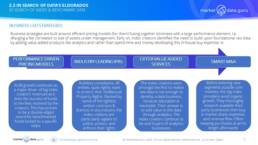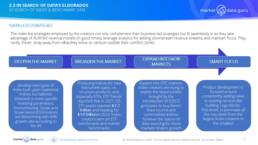GETTING TO KNOW INDEX & BENCHMARK DATA
All Indices are Benchmarks but not all Benchmarks are Indices
ETF.com tells us ‘An index is a statistical tool designed to measure performance over time’. Examples being the S&P500 and FTSE100, while a ‘benchmark is something that serves as a standard by which others are measured or judged; it is a point of reference from which measurements may be made’. Here we think of the ill-fated LIBOR and its successors.
On 3 July 1884 Charles Dow published the first stock index, the Dow Jones Transportation Index, and since then indices have been an important, and followed component of financial markets, but only since 2000 has the true value of indices come to the fore. Its big business.
- $350 Trillion in derivatives and other financial products was tied to LIBOR
- 31/12/2020 An estimated $13.5 Trillion AUM was linked to the S&P500
- 31/12/2020 Top 4 Index Creators (FTSE Russell, MSCI, Qontigo, S&PDJI) had combined revenues of $3.3 Billion, growing 67% in 5 years, with estimated 70% profit margins
- 29/09/2021 Approximately $17.9 Trillion AUM benchmarked to FTSE Russell Indices
Key Index & Benchmark Data Statistics
- 3 Million+ The number of indices calculated by the 16 members of the Index Industry Association
- 116 Index creators listed www.marketdata.guru, plus 10 alternative data, 3 digital assets, 4 PE, VC & IPO, 3 Realty & 3 luxury good specialists
- 300+ estimated number of financial benchmark producers, which is expanding rapidly
Indices and benchmarks have been around a while, but only now are they truly coming into their own. As brands, major indices like S&P500, FTSE100 are licences to print money. After a shake out and rationalisation in the 2010s new players with friendlier pricing models are entering the market. Also new markets are opening up rapidly (ESG, Alt Data, OTC, Realty) bringing more competition at the same time.
DISCOVERING INDEX & BENCHMARK DATA BUSINESSES
As I continue to argue, index creators and key individual indices are now ‘Brands’. A DJIA, S&P500, FTSE 100, Nikkei 225, MSCI Global can be replicated but not replaced. This inherently limits index competition because key indicators have become monopoly products, and financial institutions find it easier to sell products linked to specific brands, not indices the market fails to recognise.
Notably these brands are all equity indices, and while the IIA’s members lock in 95+% of these, boutique players are increasingly welcome because they are not the big index creators with high fee pricing models. The door is wide open to competition in the previously underserved OTC index world (IIA 8% bond index growth) and burgeoning ESG Index business (IIA 43% rise) where brands have yet to be established.
As the index market broadens, it is also deepening, encouraging choice, and creating two new levels of competition:
1.Smaller independent index providers which have not adopted the AUM model, such as, INDXX, ScientificBeta, and Solactive, plus the vociferously outspoken CBOE
2.Self-indexing, being embraced by the likes of Blackrock, Charles Schwab, State Street, and Vanguard, supplied by the independents
PROBLEMS IN PARADISE
- Clients are increasingly dis-satisfied with the cost of subscriptions, and lack of transparency in how the index creators’ pricing models function. Quiescence is being replaced by restlessness. Client willingness to pushback is there, but grounded in the reality that changing from one index creator to another does not solve the problem
- Regulators are interested in index fees and quality, especially if it has a negative effect on the underling costs (TER) of pensions and funds
- Data sources, primarily exchanges, are now becoming aware of how underpaid they are by index creators to use their data, and how much profit is continuously generated from their data
- The regulatory framework for creating indices for commercial purposes is clear and concise but onerous. It is why Banks dropped their indices. Unfortunately, BMR is only going one way and that is stricter rules and interpretation, which could end up being anti-competitive


INDEX & BENCHMARK DATA SUMMARY
In 2020 there was little systemic threat to the underlying businesses of the leading index creators, so the 2021 SEC fine of $9 Million passed out to S&P DJI could be a precursor to a shift in how the regulators view index businesses. This fine related to how an index functioned which caused losses to Credit Suisse.
- The business is so high margin, the leading index creators are capable of weathering future storms, waiting it out until calm returns. Even a significant drop in revenue potentially caused by a collapse in AUM would be mitigated by the high profit margins currently earnt
- Without major regulatory change, the index creators’ clients will still be bound closely to their benchmark providers. Changing index providers is hard work on many levels, even when ignoring the limited choice
- While barriers to entry are high against established benchmarks, the opening up of OTC, Realty, Alternative Data, and ESG markets is providing opportunities to new insurgents with competitive and aggressive business models
- The index consumer wants more choice, with friendlier pricing and licence models, and that is what the insurgents are offering in markets where brands have yet to be established
- Increasing use of tailored and bespoke indices for trading strategies and producing financial products deepens the use case for benchmarks and allows the consumer to simultaneously widen his index supplier base
- According to Deloitte’s 2021 ‘Investment Management Outlook’, passive funds performance is thriving compared to active funds, underlying an ongoing trend. Given passive funds are benchmark driven, this bodes well for indices in the 2020s
The notion that it is easy to create an Index is fanciful, however, once established indices can be a licence to print money.
Conclusion. The increase in passive funds by volume and value, expansion into new markets (OTC, Realty) and developing new types of indices (ESG, Thematic) combined with the integration of index data into trading strategies, models, and algorithms points towards a golden future for the successful index business
Keiren Harris 07 July 2022
Please contact info@marketdata.guru for a pdf copy of the article
For information on our consulting services please email knharris@datacompliancellc.com


